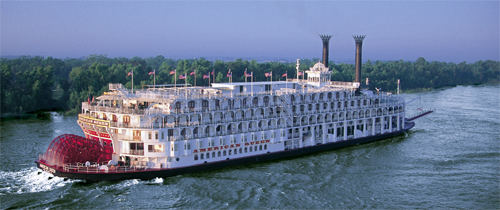The return of the refurbished American Queen sternwheeler to the U.S. inland waterways system marks a major milestone in the rebirth of the American river cruising industry.
American Queen was scheduled to return to overnight cruises on the Ohio and Mississippi rivers in April after a $6 million refit at three Bollinger shipyards. The 418-foot boat was laid up in 2008 in the custody of the U.S. Maritime Administration (MarAd) after the shutdown of its previous owner, Majestic America Line. American Queen was built with MarAd loan guarantees, and the agency took over the vessel when the owners ceased operations.
In summer 2011, Great American Steamboat Co. (GASC) bought the vessel for $15.5 million from MarAd. GASC is a subsidiary of HMS Global Maritime, a New Albany, Ind.-based operator of ferries and government vessels.
American Queen is the first vessel HMS will own and operate, according to John Waggoner, president and chief executive of HMS. Based on the acquisition and refit cost, Waggoner pegged American Queen as a sound investment.
“We’ll have about $21 million in a boat with a replacement cost of $100 million,” he said.
Built in 1995 at McDermott Shipyard, American Queen was the largest, most opulent sternwheel river cruiser ever constructed. At 3,707 gross tons, American Queen can accommodate 436 passengers in its 222 staterooms. Waggoner noted that it is the second largest U.S.-flag cruise ship in operation.
The company said it was hiring 40 professional licensed mariners to operate a full schedule of cruiser operations. At a job fair in Memphis, Tenn., for the hotel operations, more than 2,600 people applied for 300 open positions. The on-duty crew roster will be about 172, with a four-to-six-weeks-on, two-weeks-off rotation.
Returning the vessel to service required refurbishing gear that had gone bad and updating the hotel plans to modern standards, according to GASC’s Tim Rubacky, senior vice president of sales, marketing and product development.
“In the 12 years prior to lay-up, the vessel had not yet gone through a life-cycle overhaul, plus the years of dehumidification dried out rubber seals and gaskets,” he said.
The work began at the Bollinger shipyard in Sulphur, La., before the vessel moved to the yard in Morgan City, where it was dry docked for the third time in its life. Final refitting took place at Bollinger’s New Orleans yard.
HMS managed much of the work itself, using the marine crew hired for the vessel.
During the refit, the steel hull was scraped and sanded before the decks were returned to the original paint scheme, with the main deck painted red and the upper decks green. The steam-driven paddlewheel was rebuilt with new timbers.
Waggoner said that analog control systems of mid-90s vintage were replaced with state-of-the-art digital controls and the bridge wings were lengthened to accommodate larger cabinets.
The three generators were rebuilt, with two removed from the vessel for the work, including the generator ends and the windings, Waggoner noted. The DC motors for the z-drives were pulled and rebuilt, as were the z-drives themselves.
The team pulled and repainted the bow thrusters and added 20 inches of steel to the main rudders for added maneuverability.
The detailed refit, which included tightening wires in breakers and cleaning all the switchgear, was designed to avoid problems once the boat began carrying guests.
“The whole endeavor was so that basically when she comes out of the yard she really is like new or better than new,” Rubacky said.
For the hotel plan, refit work included replacing toilet lines, cleaning sink drain boxes, and cleaning and replacing carpeting in the staterooms. The Engine Room Bar underwent a complete redo, laying new hardwood cherry flooring and revarnishing the mahogany bar. The Tiffany glass on board was cleaned and restored, and 350 sets of mahogany doors were removed, stripped and polished, and rehung.
The first guests will embark for a series of shakedown cruises, with the first revenue guests coming on board April 13.
The return of American Queen is one sign of the resurgence in American river cruising. In 2009, all seven of the nation’s overnight inland cruise vessels were tied up as operators encountered financial difficulties. American Cruise Lines now offers overnight excursions on river systems in the eastern and western U.S. and on the new Queen of the Mississippi, which is expected to begin operation in August.
Waggoner said the U.S. cruising industry failed due to management problems, not a lack of demand.
“Three years ago, there were four cruise boats operating on the Ohio and Mississippi rivers,” he said. “If the American Queen were to sail 100 percent full, we would still serve only 43 percent of the market that was there three years ago.”

